Review of a Bill: Nurse Staffing Standards for Hospital Safety
VerifiedAdded on 2022/09/07
|6
|1201
|36
Report
AI Summary
This report provides a comprehensive review of the Nurse Staffing Standards for Hospital Patient Safety and Quality Care Act of 2017. It begins with a historical overview, tracing the bill's origins and legislative journey, including its introduction in the 115th Congress and its proposed amendment to the Public Health Service Act. The report details the major provisions of the bill, such as the establishment of minimum nurse-to-patient ratios, hospital staffing plan submissions, and protections for nurses who refuse assignments. It delves into the understanding of the legislation, highlighting the federal government's interest in promoting quality healthcare and reducing medical errors. The report identifies key supporters, such as the California Nurses Association, and discusses the pros and cons of the bill, including its potential impact on patient care and the nursing profession. Additionally, it examines the bill's impact on nurses' ability to provide safe and quality care and the actions nurses can take if the bill becomes law. The report references primary sources like the Public Health Service Act of 1944 and relevant studies to support its analysis.
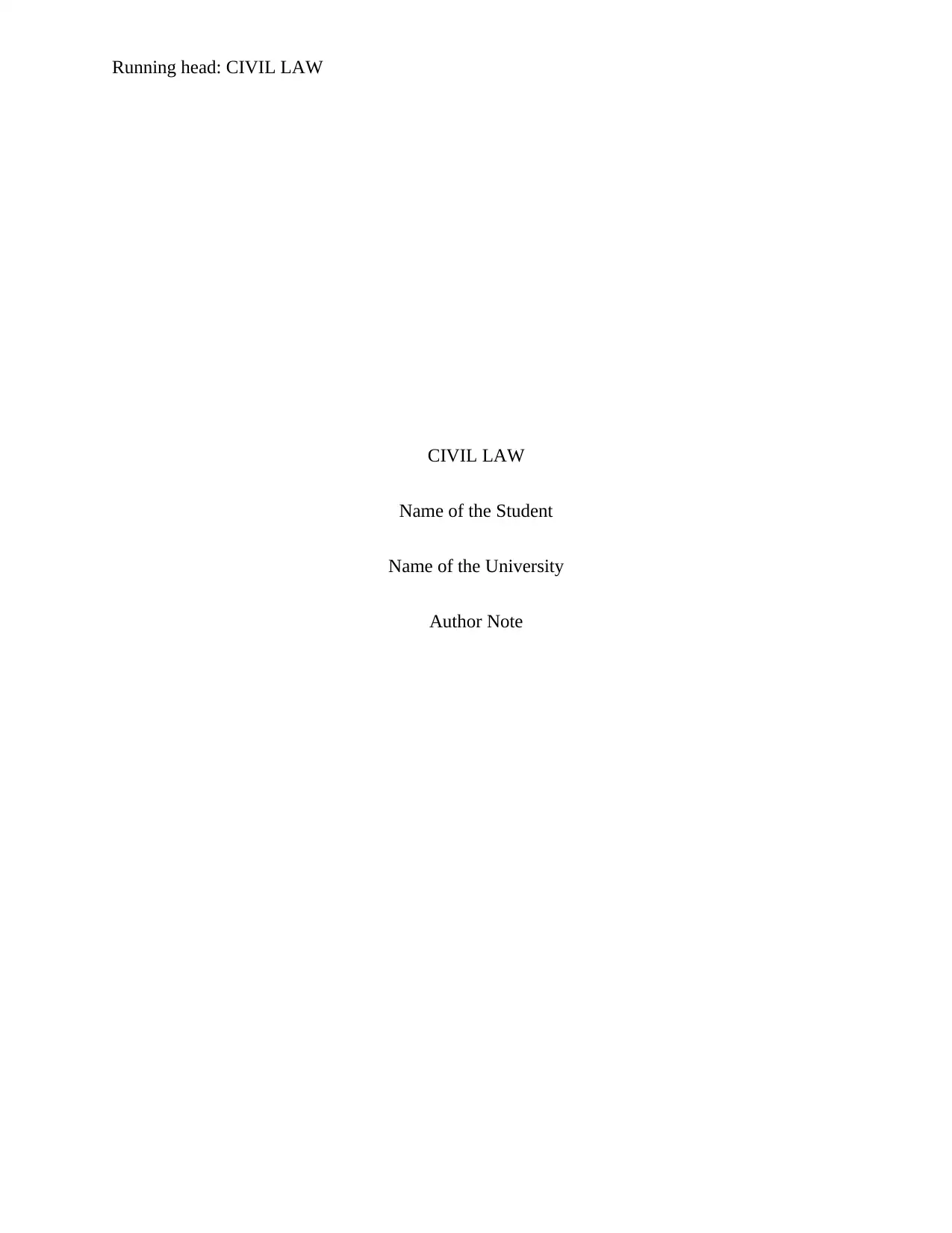
Running head: CIVIL LAW
CIVIL LAW
Name of the Student
Name of the University
Author Note
CIVIL LAW
Name of the Student
Name of the University
Author Note
Paraphrase This Document
Need a fresh take? Get an instant paraphrase of this document with our AI Paraphraser
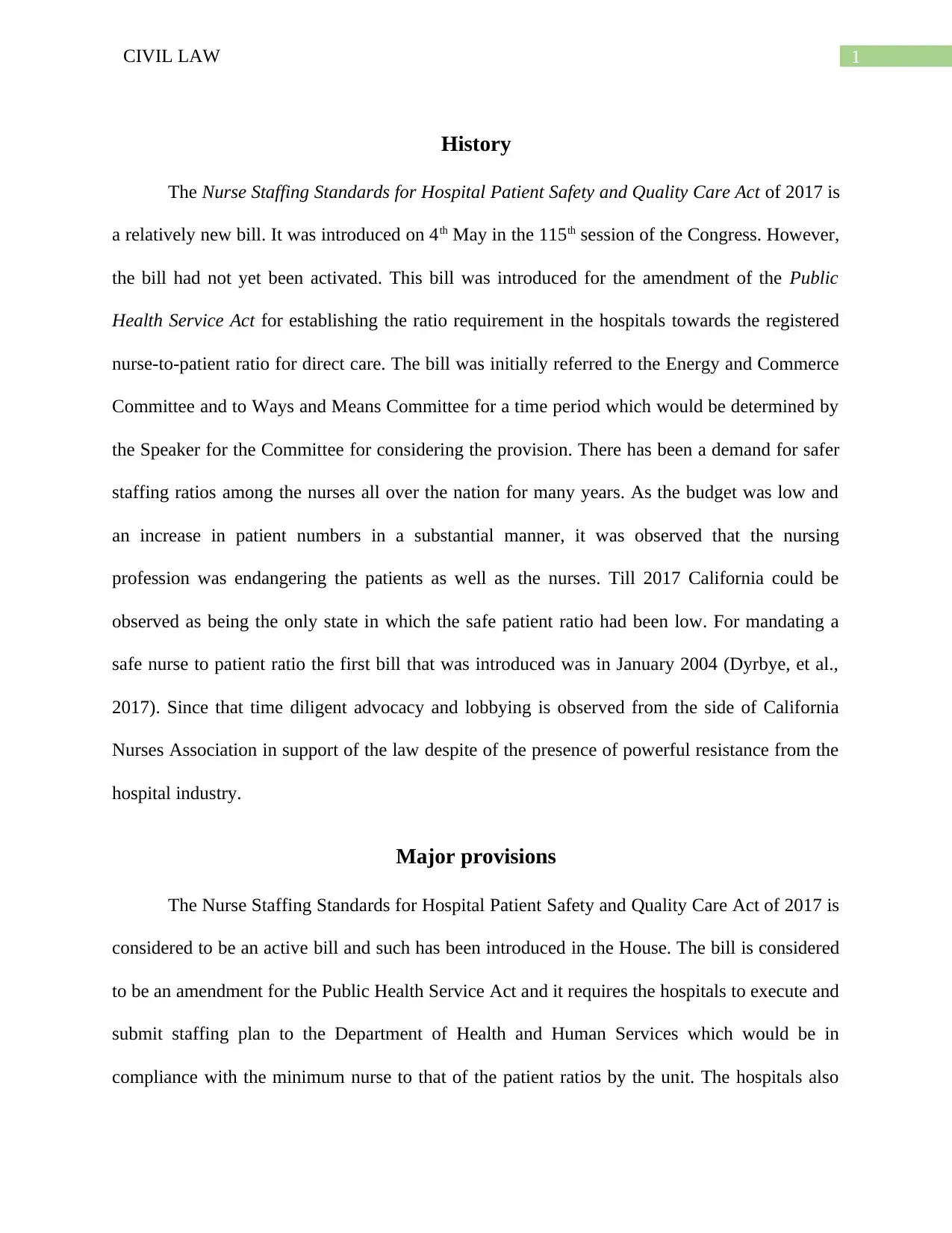
1CIVIL LAW
History
The Nurse Staffing Standards for Hospital Patient Safety and Quality Care Act of 2017 is
a relatively new bill. It was introduced on 4th May in the 115th session of the Congress. However,
the bill had not yet been activated. This bill was introduced for the amendment of the Public
Health Service Act for establishing the ratio requirement in the hospitals towards the registered
nurse-to-patient ratio for direct care. The bill was initially referred to the Energy and Commerce
Committee and to Ways and Means Committee for a time period which would be determined by
the Speaker for the Committee for considering the provision. There has been a demand for safer
staffing ratios among the nurses all over the nation for many years. As the budget was low and
an increase in patient numbers in a substantial manner, it was observed that the nursing
profession was endangering the patients as well as the nurses. Till 2017 California could be
observed as being the only state in which the safe patient ratio had been low. For mandating a
safe nurse to patient ratio the first bill that was introduced was in January 2004 (Dyrbye, et al.,
2017). Since that time diligent advocacy and lobbying is observed from the side of California
Nurses Association in support of the law despite of the presence of powerful resistance from the
hospital industry.
Major provisions
The Nurse Staffing Standards for Hospital Patient Safety and Quality Care Act of 2017 is
considered to be an active bill and such has been introduced in the House. The bill is considered
to be an amendment for the Public Health Service Act and it requires the hospitals to execute and
submit staffing plan to the Department of Health and Human Services which would be in
compliance with the minimum nurse to that of the patient ratios by the unit. The hospitals also
History
The Nurse Staffing Standards for Hospital Patient Safety and Quality Care Act of 2017 is
a relatively new bill. It was introduced on 4th May in the 115th session of the Congress. However,
the bill had not yet been activated. This bill was introduced for the amendment of the Public
Health Service Act for establishing the ratio requirement in the hospitals towards the registered
nurse-to-patient ratio for direct care. The bill was initially referred to the Energy and Commerce
Committee and to Ways and Means Committee for a time period which would be determined by
the Speaker for the Committee for considering the provision. There has been a demand for safer
staffing ratios among the nurses all over the nation for many years. As the budget was low and
an increase in patient numbers in a substantial manner, it was observed that the nursing
profession was endangering the patients as well as the nurses. Till 2017 California could be
observed as being the only state in which the safe patient ratio had been low. For mandating a
safe nurse to patient ratio the first bill that was introduced was in January 2004 (Dyrbye, et al.,
2017). Since that time diligent advocacy and lobbying is observed from the side of California
Nurses Association in support of the law despite of the presence of powerful resistance from the
hospital industry.
Major provisions
The Nurse Staffing Standards for Hospital Patient Safety and Quality Care Act of 2017 is
considered to be an active bill and such has been introduced in the House. The bill is considered
to be an amendment for the Public Health Service Act and it requires the hospitals to execute and
submit staffing plan to the Department of Health and Human Services which would be in
compliance with the minimum nurse to that of the patient ratios by the unit. The hospitals also
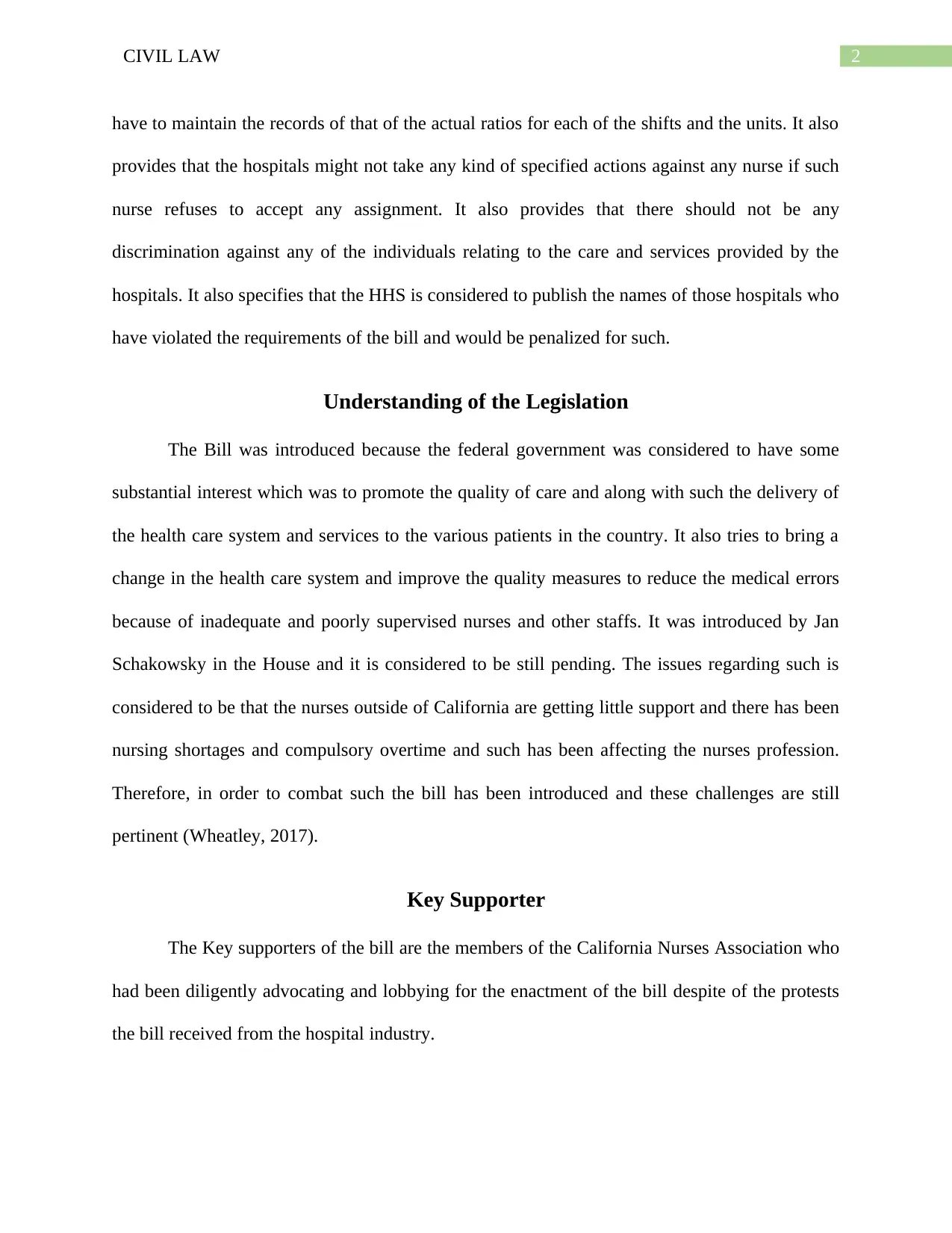
2CIVIL LAW
have to maintain the records of that of the actual ratios for each of the shifts and the units. It also
provides that the hospitals might not take any kind of specified actions against any nurse if such
nurse refuses to accept any assignment. It also provides that there should not be any
discrimination against any of the individuals relating to the care and services provided by the
hospitals. It also specifies that the HHS is considered to publish the names of those hospitals who
have violated the requirements of the bill and would be penalized for such.
Understanding of the Legislation
The Bill was introduced because the federal government was considered to have some
substantial interest which was to promote the quality of care and along with such the delivery of
the health care system and services to the various patients in the country. It also tries to bring a
change in the health care system and improve the quality measures to reduce the medical errors
because of inadequate and poorly supervised nurses and other staffs. It was introduced by Jan
Schakowsky in the House and it is considered to be still pending. The issues regarding such is
considered to be that the nurses outside of California are getting little support and there has been
nursing shortages and compulsory overtime and such has been affecting the nurses profession.
Therefore, in order to combat such the bill has been introduced and these challenges are still
pertinent (Wheatley, 2017).
Key Supporter
The Key supporters of the bill are the members of the California Nurses Association who
had been diligently advocating and lobbying for the enactment of the bill despite of the protests
the bill received from the hospital industry.
have to maintain the records of that of the actual ratios for each of the shifts and the units. It also
provides that the hospitals might not take any kind of specified actions against any nurse if such
nurse refuses to accept any assignment. It also provides that there should not be any
discrimination against any of the individuals relating to the care and services provided by the
hospitals. It also specifies that the HHS is considered to publish the names of those hospitals who
have violated the requirements of the bill and would be penalized for such.
Understanding of the Legislation
The Bill was introduced because the federal government was considered to have some
substantial interest which was to promote the quality of care and along with such the delivery of
the health care system and services to the various patients in the country. It also tries to bring a
change in the health care system and improve the quality measures to reduce the medical errors
because of inadequate and poorly supervised nurses and other staffs. It was introduced by Jan
Schakowsky in the House and it is considered to be still pending. The issues regarding such is
considered to be that the nurses outside of California are getting little support and there has been
nursing shortages and compulsory overtime and such has been affecting the nurses profession.
Therefore, in order to combat such the bill has been introduced and these challenges are still
pertinent (Wheatley, 2017).
Key Supporter
The Key supporters of the bill are the members of the California Nurses Association who
had been diligently advocating and lobbying for the enactment of the bill despite of the protests
the bill received from the hospital industry.
⊘ This is a preview!⊘
Do you want full access?
Subscribe today to unlock all pages.

Trusted by 1+ million students worldwide
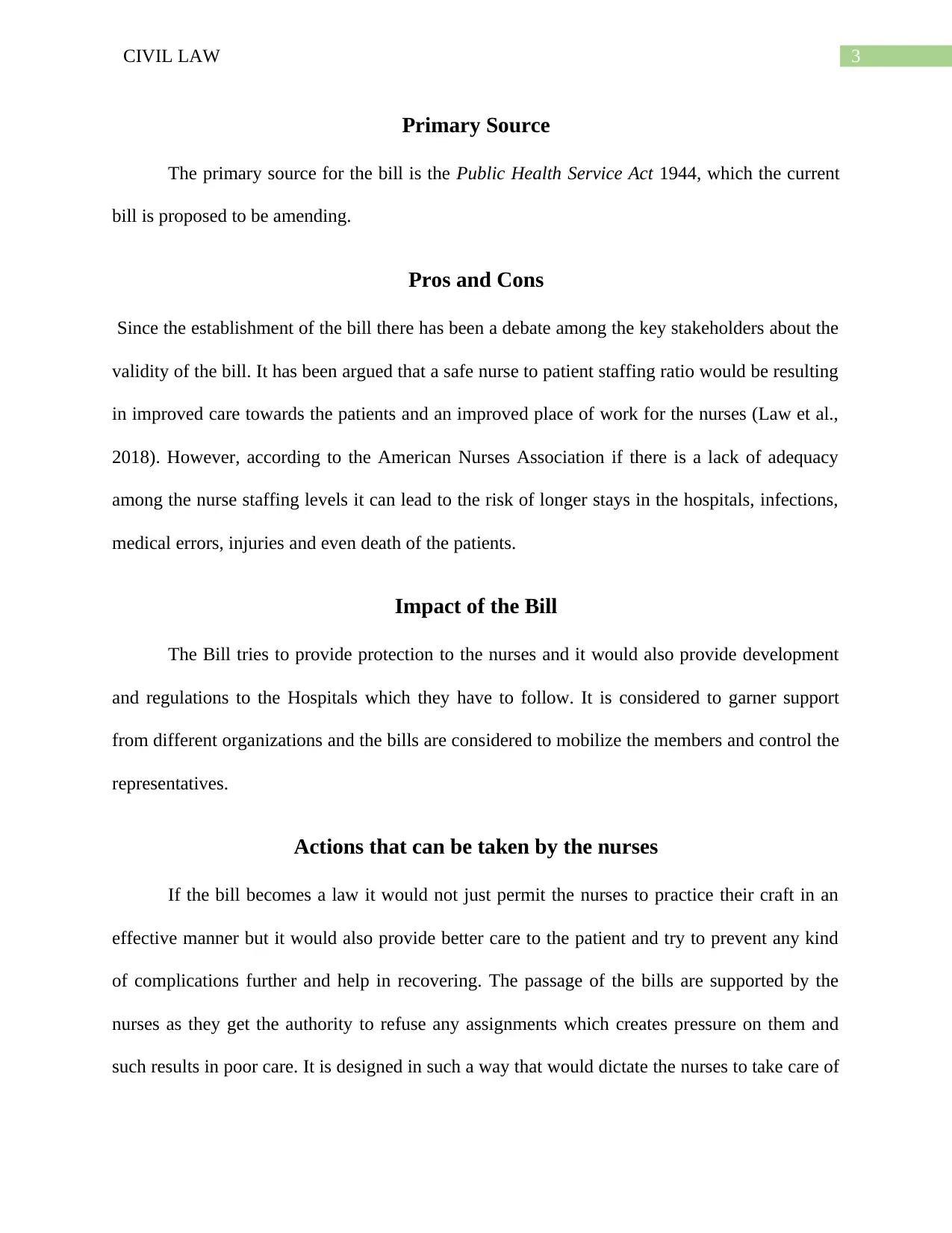
3CIVIL LAW
Primary Source
The primary source for the bill is the Public Health Service Act 1944, which the current
bill is proposed to be amending.
Pros and Cons
Since the establishment of the bill there has been a debate among the key stakeholders about the
validity of the bill. It has been argued that a safe nurse to patient staffing ratio would be resulting
in improved care towards the patients and an improved place of work for the nurses (Law et al.,
2018). However, according to the American Nurses Association if there is a lack of adequacy
among the nurse staffing levels it can lead to the risk of longer stays in the hospitals, infections,
medical errors, injuries and even death of the patients.
Impact of the Bill
The Bill tries to provide protection to the nurses and it would also provide development
and regulations to the Hospitals which they have to follow. It is considered to garner support
from different organizations and the bills are considered to mobilize the members and control the
representatives.
Actions that can be taken by the nurses
If the bill becomes a law it would not just permit the nurses to practice their craft in an
effective manner but it would also provide better care to the patient and try to prevent any kind
of complications further and help in recovering. The passage of the bills are supported by the
nurses as they get the authority to refuse any assignments which creates pressure on them and
such results in poor care. It is designed in such a way that would dictate the nurses to take care of
Primary Source
The primary source for the bill is the Public Health Service Act 1944, which the current
bill is proposed to be amending.
Pros and Cons
Since the establishment of the bill there has been a debate among the key stakeholders about the
validity of the bill. It has been argued that a safe nurse to patient staffing ratio would be resulting
in improved care towards the patients and an improved place of work for the nurses (Law et al.,
2018). However, according to the American Nurses Association if there is a lack of adequacy
among the nurse staffing levels it can lead to the risk of longer stays in the hospitals, infections,
medical errors, injuries and even death of the patients.
Impact of the Bill
The Bill tries to provide protection to the nurses and it would also provide development
and regulations to the Hospitals which they have to follow. It is considered to garner support
from different organizations and the bills are considered to mobilize the members and control the
representatives.
Actions that can be taken by the nurses
If the bill becomes a law it would not just permit the nurses to practice their craft in an
effective manner but it would also provide better care to the patient and try to prevent any kind
of complications further and help in recovering. The passage of the bills are supported by the
nurses as they get the authority to refuse any assignments which creates pressure on them and
such results in poor care. It is designed in such a way that would dictate the nurses to take care of
Paraphrase This Document
Need a fresh take? Get an instant paraphrase of this document with our AI Paraphraser
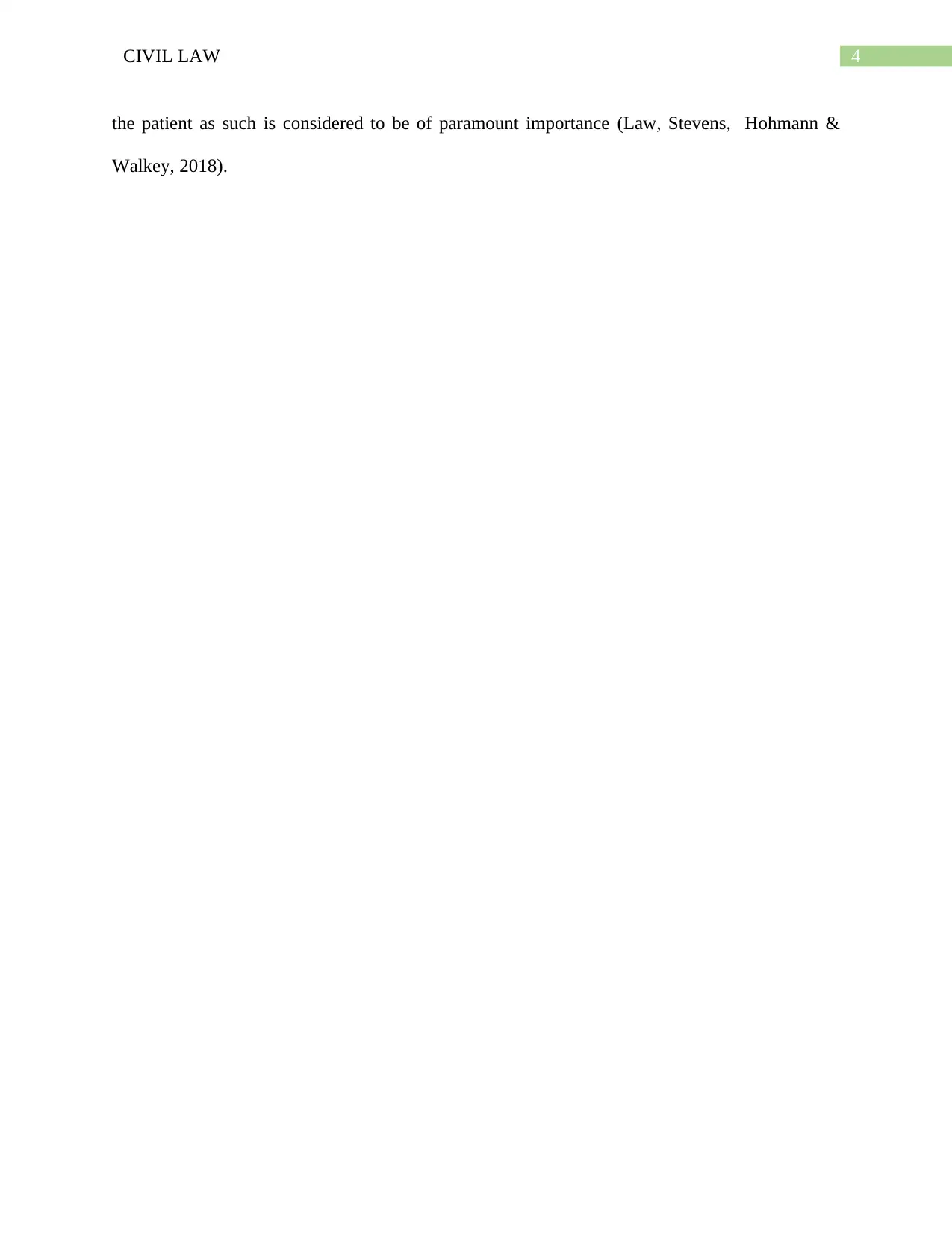
4CIVIL LAW
the patient as such is considered to be of paramount importance (Law, Stevens, Hohmann &
Walkey, 2018).
the patient as such is considered to be of paramount importance (Law, Stevens, Hohmann &
Walkey, 2018).
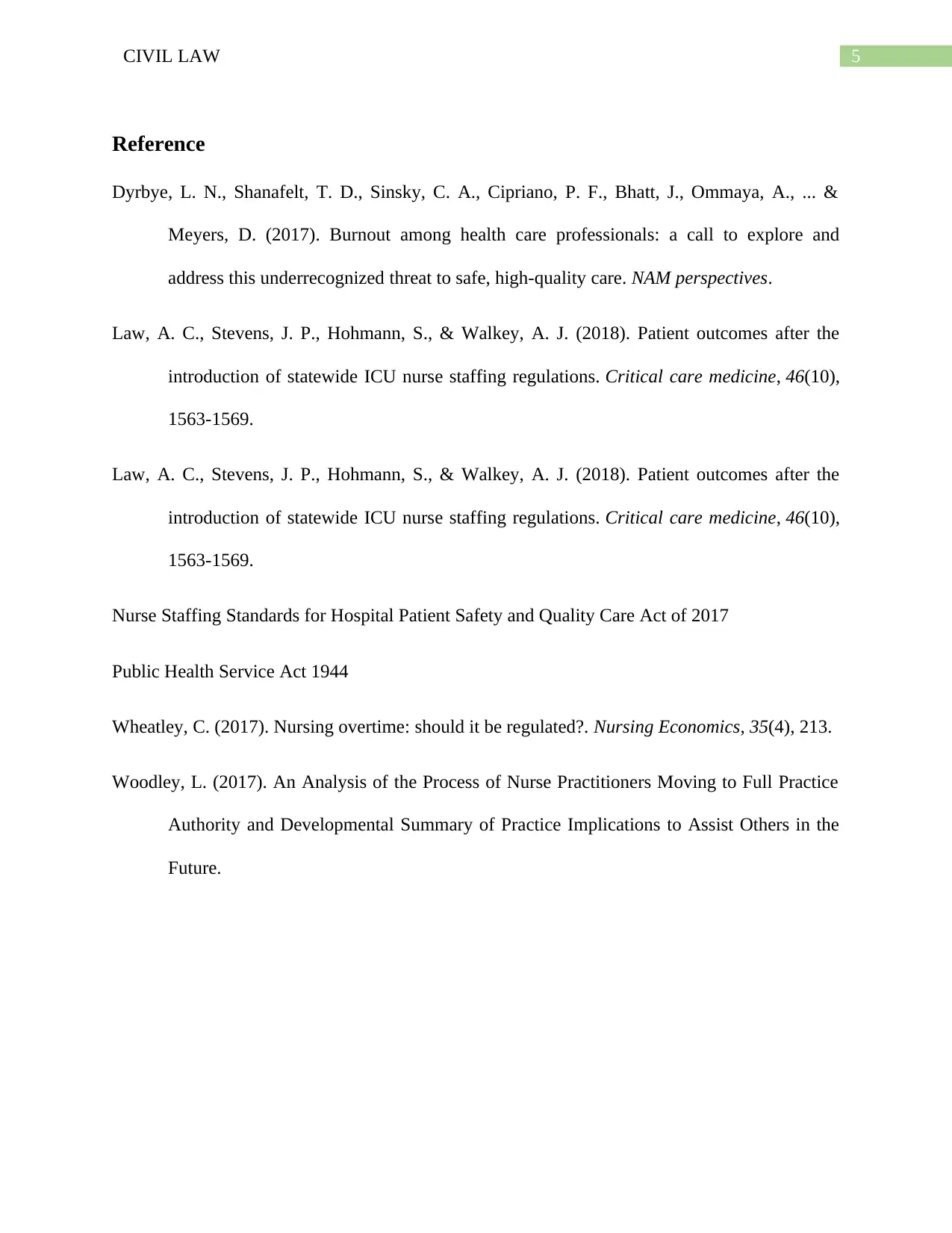
5CIVIL LAW
Reference
Dyrbye, L. N., Shanafelt, T. D., Sinsky, C. A., Cipriano, P. F., Bhatt, J., Ommaya, A., ... &
Meyers, D. (2017). Burnout among health care professionals: a call to explore and
address this underrecognized threat to safe, high-quality care. NAM perspectives.
Law, A. C., Stevens, J. P., Hohmann, S., & Walkey, A. J. (2018). Patient outcomes after the
introduction of statewide ICU nurse staffing regulations. Critical care medicine, 46(10),
1563-1569.
Law, A. C., Stevens, J. P., Hohmann, S., & Walkey, A. J. (2018). Patient outcomes after the
introduction of statewide ICU nurse staffing regulations. Critical care medicine, 46(10),
1563-1569.
Nurse Staffing Standards for Hospital Patient Safety and Quality Care Act of 2017
Public Health Service Act 1944
Wheatley, C. (2017). Nursing overtime: should it be regulated?. Nursing Economics, 35(4), 213.
Woodley, L. (2017). An Analysis of the Process of Nurse Practitioners Moving to Full Practice
Authority and Developmental Summary of Practice Implications to Assist Others in the
Future.
Reference
Dyrbye, L. N., Shanafelt, T. D., Sinsky, C. A., Cipriano, P. F., Bhatt, J., Ommaya, A., ... &
Meyers, D. (2017). Burnout among health care professionals: a call to explore and
address this underrecognized threat to safe, high-quality care. NAM perspectives.
Law, A. C., Stevens, J. P., Hohmann, S., & Walkey, A. J. (2018). Patient outcomes after the
introduction of statewide ICU nurse staffing regulations. Critical care medicine, 46(10),
1563-1569.
Law, A. C., Stevens, J. P., Hohmann, S., & Walkey, A. J. (2018). Patient outcomes after the
introduction of statewide ICU nurse staffing regulations. Critical care medicine, 46(10),
1563-1569.
Nurse Staffing Standards for Hospital Patient Safety and Quality Care Act of 2017
Public Health Service Act 1944
Wheatley, C. (2017). Nursing overtime: should it be regulated?. Nursing Economics, 35(4), 213.
Woodley, L. (2017). An Analysis of the Process of Nurse Practitioners Moving to Full Practice
Authority and Developmental Summary of Practice Implications to Assist Others in the
Future.
⊘ This is a preview!⊘
Do you want full access?
Subscribe today to unlock all pages.

Trusted by 1+ million students worldwide
1 out of 6
Related Documents
Your All-in-One AI-Powered Toolkit for Academic Success.
+13062052269
info@desklib.com
Available 24*7 on WhatsApp / Email
![[object Object]](/_next/static/media/star-bottom.7253800d.svg)
Unlock your academic potential
Copyright © 2020–2025 A2Z Services. All Rights Reserved. Developed and managed by ZUCOL.





